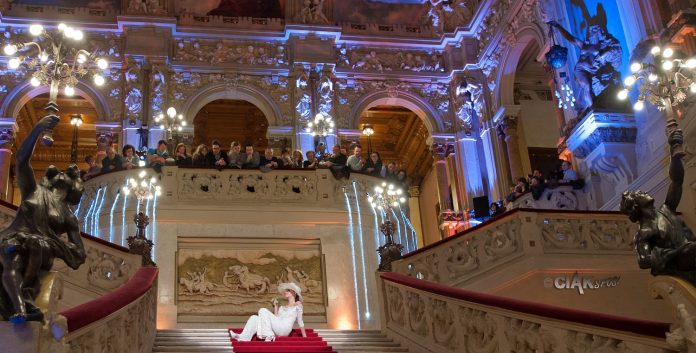The Casinò Municipale di San Pellegrino Terme has a charming, exclusive Art Nouveau atmosphere. With its majestic beauty and the ornamental richness both of its interior and exterior, it is a splendid setting perhaps even the perfect place to experiment with lighting to enhance its elegance and bring back to mind the splendour of the Belle Époque.
Longhi Banqueting had the idea of illuminating the casino. This catering company contacted the Lighting Designer, Giuseppe Cividini, and asked him to design show lighting for the building.
“We got a lot of ideas from the technical inspection and came up with solutions for carrying out the work inside the building and on the façade. It was necessary to dim down the areas that were too brightly lit and illuminate the poorly lit parts to make them stand out at their best,” Giuseppe said.
“The main work was done with Clay Paky GlowUps: we installed over a hundred of them, outside, inside and in the rooms. For example, each column around the perimeter of the hall was enhanced with a GlowUp, placed on the ground and pointing upwards. It was a solution designed to change the shade of the walls.”
However Giuseppe is also especially proud of how he managed to make the best of some of the less up-to-date Clay Paky lights he had in stock: a vintage installation in all respects.
“The ceiling of the main hall was illuminated with a slight moving water effect created with just four Clay Paky V.I.P. 300s together with a Clay Paky glass optical unit from 1995 with the right focus, a rotary movement and the addition of prisms to the lights that quadrupled the beam angle and therefore the projected effect. The V.I.P. 300s were raised and arranged in the four corners of the hall so as to pass unnoticed.
The exterior was lit on two levels. We began by illuminating the façade of the casino starting from the bottom up with outdoor Clay Paky CP Colour 150s. Six were needed for the lower part of the building and five were placed on the terraces to illuminate the top of the building and create a colour continuity. To illuminate the whole upper façade properly including the stringcourse, which would otherwise have been in the shadow, two other architectural lights were placed some distance away, another two V.I.P. 300s.
“We completed the lighting by adding 10 CP Spots at the base of the pillars to give the façade greater dynamism and depth. The CP Spots were fitted with an OSRAM halogen lamp with a 6° beam angle to illuminate the large pillars with a very narrow beam of warm white light. In this way, any shade of colour used with the CP Colour 150 was in keeping with the light on the pillars. To obtain different levels of luminous depth, especially in architecture, you have to balance the colours with white light: never use a single shade, which flattens all the solids and their shadows significantly.”
“Even the most playful effects to illuminate the wedding cake and bride and groom were created with Clay Paky lights, whereas the lighting of the backdrop behind them was done with Fort Fibre optical fibres, provided by Clay Paky along with their V.I.P. 300s, and plates suitable for connecting them.
We managed to find a way of animating the optical fibres with the V.I.P 300s. The fibres were static and white, but using a perforated blue filter I was able to transmit moving light along them.
Four hundred six-metre-long threads of optical fibre fell to the ground from the main terrace into the hall of the Casinò Municipale di San Pellegrino Terme. They were arranged singly or in bunches of two or four, and lit and animated by two V.I.P 300s like a waterfall.”





